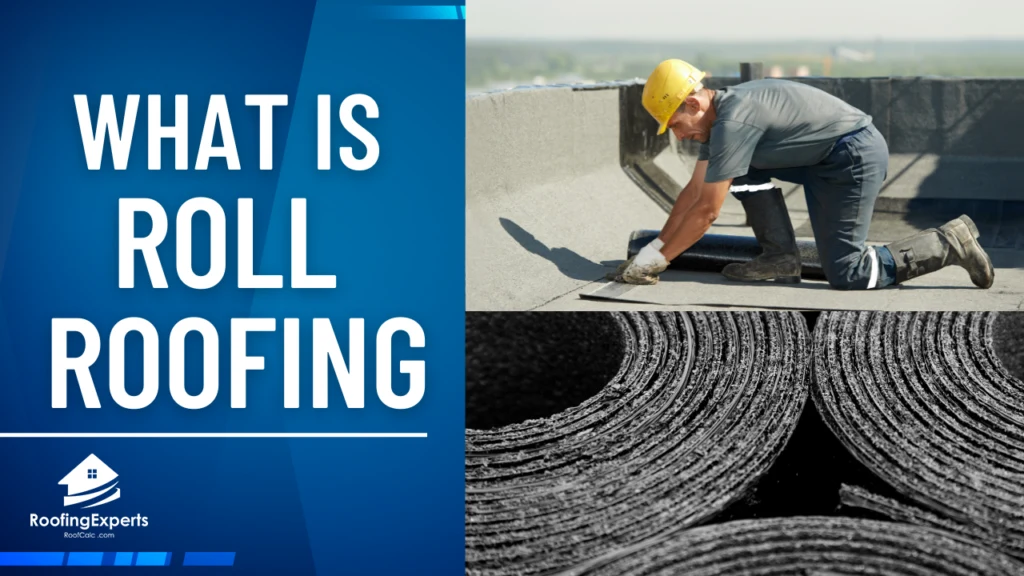
Roll roofing is a cost-effective and practical roofing solution that’s gaining popularity among homeowners and contractors alike. If you’re considering roll roofing for your home or building, you’ve come to the right place!
In this article, we’ll dive into what roll roofing is, how it’s installed, and the benefits and drawbacks of this roofing material.
We’ll also share tips and things you need to know to help you make an informed decision and ensure a successful installation.
So, whether you’re a DIY enthusiast or looking to hire a professional, keep reading to learn everything you need to know about roll roofing!
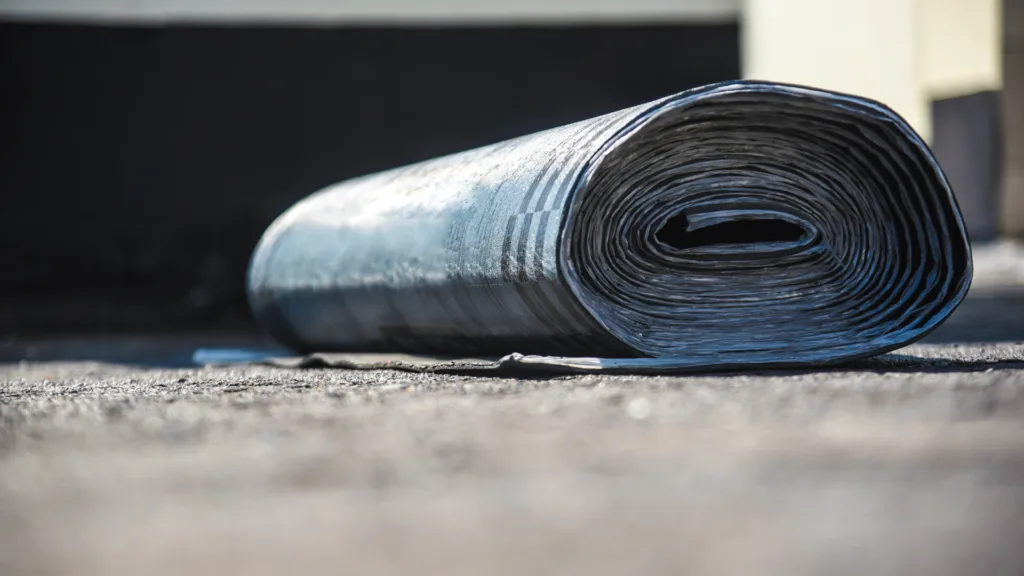
Types of Roll Roofing Materials
In this section, we will discuss the different types of roll roofing materials available. Understanding the properties and features of each material will help you make informed decisions when choosing the best option for your project.
Asphalt Roll Roofing
Asphalt roll roofing is a common and budget-friendly option. This material is made using saturated organic felts or fiberglass mats that are coated in asphalt.
It offers fair weather resistance and a moderate lifespan. Some advantages of asphalt roll roofing include:
- Affordable and widely available
- Easy installation process
- Provides reasonable protection against weather elements
However, asphalt roll roofing is not the most durable or long-lasting option and may require more frequent maintenance and replacement compared to other materials.
Mineral-Surfaced Roll Roofing
Mineral-surfaced roll roofing (MSR) is similar to asphalt roll roofing, but it has an added layer of mineral granules on the surface. This provides additional protection against weather elements and UV radiation.
The benefits of mineral-surfaced roll roofing include:
- Enhanced durability compared to asphalt roll roofing
- Improved UV resistance
- Better traction when walking on the roof
On the other hand, MSR roofing is heavier than standard asphalt roll roofing and may require additional structural support during installation.
Rubber Roll Roofing
Rubber roll roofing, often made from EPDM (ethylene propylene diene monomer) or TPO (thermoplastic olefin) materials, is a versatile and durable option. This material is resistant to weather, UV radiation, and can withstand temperature fluctuations.
Here are some advantages of using rubber roll roofing:
- Excellent durability and resistance to weather elements
- Flexible, allowing for easy installation on irregular surfaces
- Environmentally friendly, as it is recyclable and has a low impact on energy consumption
However, rubber roll roofing may cost more upfront compared to asphalt or mineral-surfaced roofing options.
Fiberglass Roll Roofing
Fiberglass roll roofing is manufactured using fiberglass mats that are coated with asphalt and topped with a mineral surface. This material is more durable than organic felt-based options, as the fiberglass reinforcement increases its strength and resistance to moisture.
Some benefits of fiberglass roll roofing are:
- Higher resistance to moisture and rot compared to organic felt-based roofing
- Improved fire resistance due to the fiberglass core
- Lightweight and easy to handle during installation
Keep in mind that, like other types of roll roofing, fiberglass roll roofing may not be as durable as traditional shingles or other more robust roofing materials.
By considering the unique features and benefits of each roll roofing material, you can select the most suitable option for your specific needs and preferences.
Ensure that you consult with a professional and follow the manufacturer’s recommendations to achieve optimal results during installation.
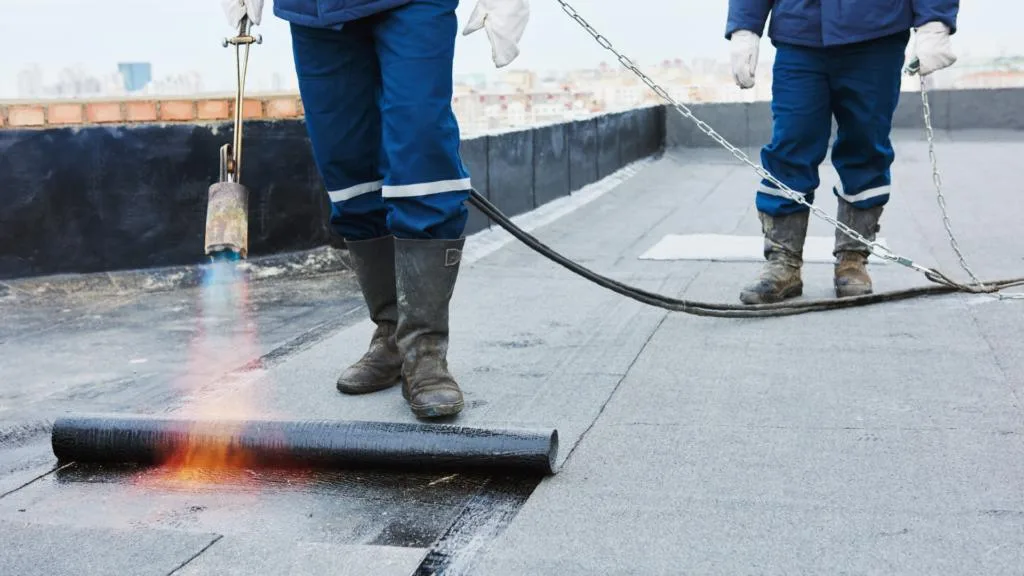
Advantages Of Roll Roofing
One key advantage of roll roofing is that it is inexpensive, making it a budget-friendly option for homeowners looking to save on their roofing costs.
Since it is one of the most affordable roofing materials on the market, you can expect to spend less on materials compared to other options.
The installation process for roll roofing is relatively easy, even for DIY enthusiasts. This simplicity can save you on labor costs if you decide to tackle the project yourself.
Most types of rolled roofing materials can be applied directly to the roof deck. Some require peeling away a paperback, while others require applying an adhesive to the roof first before rolling the material into place.
Here are some additional benefits of roll roofing:
- Usable for low-incline roofs: Roll roofing is suitable for roofs with a slight slope, providing a versatile option for various roof designs.
- Quick installation: Due to its simple application process, roll roofing can be installed quickly, which is helpful if you need urgent repairs or a temporary fix.
Keep in mind that, while roll roofing has its advantages, it is generally thinner and less durable than other roofing materials like shingles.
However, its cost-effectiveness and ease of installation make it a popular choice for many homeowners, especially when a more temporary solution is needed.
Disadvantages Of Roll Roofing
Short Lifespan
One notable drawback of roll roofing, also known as mineral surface roofing, is its relatively short lifespan. While some selections like EDMP and Bitumen can last for up to 20 years, other common roll roofing types have an average lifespan of 5 to 8 years.
Comparatively, traditional shingle roofs tend to have a longer life.
Less Durable Than Shingles
Roll roofing material is thinner and less durable than shingles. Due to its design, roll roofing is more susceptible to tearing or cracking, as it cannot distribute stress across a wide area like individual shingles can.
For this reason, roll roofing is not the best option for residential or commercial properties, making it better suited to garages, workshops, barns, and small shops.
Limited Color Choices
Another disadvantage of roll roofing is its limited selection of colors. You might find that your choices are constrained mainly to black and sometimes green.
This can make it difficult to match the roll roofing to the overall aesthetic of your property.
Temporary Fix
Lastly, you should consider that roll roofing is typically seen as a temporary solution. Due to its lack of durability and short lifespan, it is not an ideal long-term roofing option.
As a result, you might face the need for frequent replacements or repairs, which can become costly and time-consuming in the long run.
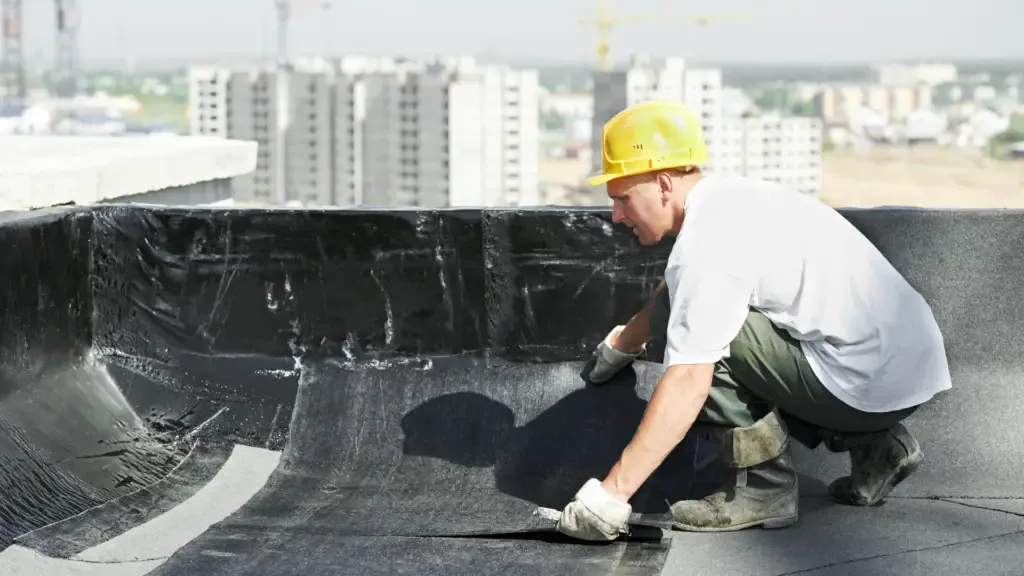
Suitable Applications
Roll roofing is an ideal choice for low-sloped, low-incline, and flat roofs, making it a popular option for unoccupied structures and outbuildings. Some of the most common applications include:
- Sheds: Due to their typically low pitch, roll roofing works well for sheds, providing both protection and affordability.
- Garages: Roll roofing can be a cost-effective way of protecting your vehicles from the elements in detached garages.
- Workshops: For workshops or storage areas, roll roofing provides a functional and budget-friendly option.
- Treehouses: If you’re building a treehouse, you can consider using roll roofing to protect it from rain and other elements.
In addition to these, roll roofing is well-suited for shops, gazebos, and other structures where aesthetics are not the primary concern. The ease of installation and low cost make it a practical choice for a variety of applications.
Just remember to ensure proper installation, as its durability and lifespan may be shorter compared to other roofing materials.
Installation Process
Tools And Materials
Before starting the installation process, gather all necessary tools and materials. You will need:
- Safety equipment (gloves, safety glasses, and a harness if working on a steep roof)
- Measuring tape
- Chalk line
- Trowel
- Roofing nails
- Roofing cement
- Hardware (flashing or eave strip for edges)
- Underlayment, if needed
- Roll roofing
Preparation
As a crucial first step, calculate your roof’s square area and measurements to determine how much roll roofing material you’ll need. Make sure that the roof surface is clean and free of debris to ensure proper adhesion.
Additionally, ensure that the weather conditions are favorable for installation.
Underlayment
If necessary, install an underlayment prior to laying the roll roofing. Underlayment acts as a barrier to protect against leaks and is typically required over bare wood sheathing.
To apply underlayment:
- Roll out underlayment across the roof deck, starting at the lowest point.
- Secure it with roofing nails, placing them 12-15 inches apart along the edges.
- Overlap seams by at least two inches.
- Cut underlayment to fit around any roof penetrations, such as vents or chimneys.
Laying Roll Roofing
Start the installation at the bottom edge of the roof. To ensure a straight line, use a measuring tape and chalk line to mark 35 inches up from the bottom edge.
Apply a 1/8-1/4 inch thick layer of roofing cement on the marked line, working in sections along the edges.
Next, align the bottom edge of the roll roofing material to the chalk line with a 1/4 inch overhang. Press the roofing into the cement and nail the top edge (the mineral coating-free part) using roofing nails.
Avoid nailing through the mineral coating to prevent damaging the material.
Finishing Touches
Properly securing and sealing edges, valleys, and roof penetrations is essential to a long-lasting roll roof. Install flashing, valley material, or an eave strip on the edges before installing roll roofing to provide additional protection.
Overlap sections of roll roofing and seal each seam with roofing cement, paying special attention to corners and penetrations.
By following these steps and taking the necessary safety precautions, you can successfully install a durable and effective roll roof on your structure.
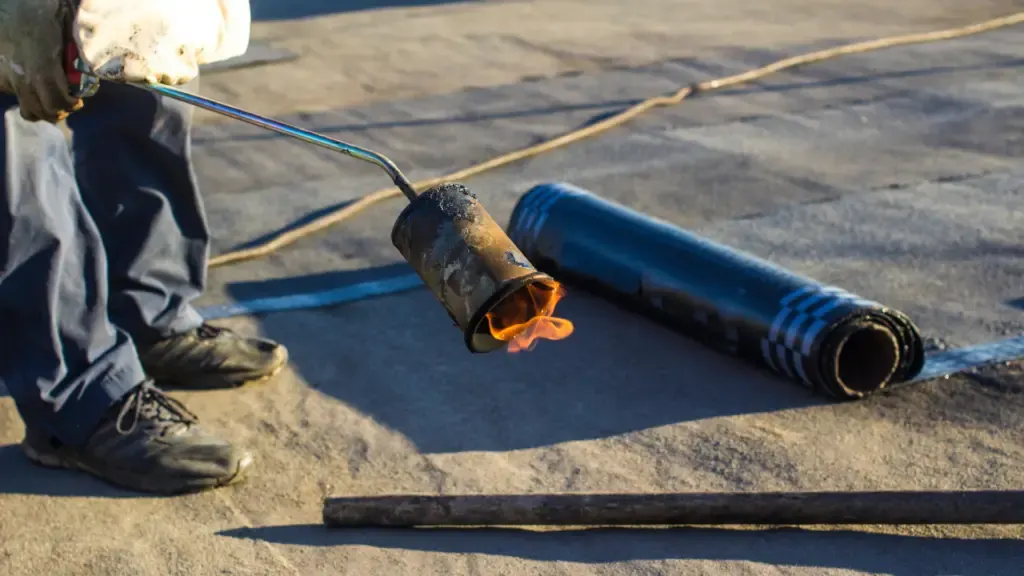
Maintenance And Durability
Roll roofing is known for its durability and low maintenance requirements. It can withstand high winds, heavy rains, fire, and pests. This makes it a suitable option for homes in areas prone to these hazards.
The lifespan of roll roofing largely depends on the quality of the material and the installation process. Typically, you can expect it to last for about 10-15 years if you maintain it properly.
Ensuring proper sheathing and ventilation can help extend the life of your roll roofing.
To keep your roll roofing in good condition, you should clean it occasionally. Cleaning involves removing any accumulated debris such as leaves, twigs, and dirt, which could otherwise cause rot, algae growth, or even eventual leaks.
To clean your roll roofing, gently use a soft brush or a low-pressure water hose to remove debris. Avoid using high-pressure water as it can cause damage to the roofing material.
When cleaning your roll roofing, pay attention to any potential issues such as creasing, which can lead to tears or cracks if left unaddressed. If you notice any creasing, it’s crucial to fix the issue promptly to prevent further damage.
In summary, roll roofing is a durable and low-maintenance option for various roofing projects. By maintaining and cleaning it regularly, you can extend its lifespan and keep it looking its best.
However, make sure to monitor for any signs of wear and tear, fix issues as they arise, and consult with a professional if you’re unsure about any aspect of roll roofing maintenance.
Roofing Alternatives
When considering alternatives to roll roofing, you have several options. Each type of roofing material offers its own benefits and drawbacks. Some popular options include:
Shingles
Shingles are one of the most common roofing materials. They can be made from a variety of materials, such as asphalt, wood, and composite. Asphalt shingles are well-known for their affordability and ease of installation.
Wood shingles, while more expensive, offer a natural appearance and can last up to 30 years if maintained properly. Composite shingles combine the best of both worlds, providing durability and an attractive appearance.
Tiles
Tiles are another popular roofing choice, available in materials such as clay, concrete, and slate. Clay and concrete tiles are known for their durability, lasting up to 50 years or more, while slate tiles offer a unique and elegant appearance.
However, tile roofing can be heavy and may require additional structural support for your roof.
Metal Roofing
Metal roofing is a durable and long-lasting option. Common materials used for metal roofs include steel, galvanized steel, and aluminum.
Metal roofs can last up to 50 years and are an excellent choice for areas with extreme weather conditions. They are also eco-friendly, as they can be recycled at the end of their lifespan.
EPDM Roofing
EPDM (ethylene propylene diene monomer) is a type of rubber roofing typically used for flat or low-slope roofs. It offers excellent resistance to weather and temperature extremes, making it a durable choice. EPDM roofing can also be energy-efficient, as it reflects heat and helps reduce energy costs.
When choosing a roofing alternative, keep in mind factors such as cost, durability, appearance, and maintenance requirements.
By considering these factors, you can find the best option for your needs and ensure a long-lasting, attractive roof for your home.

Cost And Budget Considerations
When considering roll roofing for your home, it’s important to keep in mind the various cost factors that can affect your overall budget. Roll roofing is known for being a cost-effective and budget-friendly option, especially when compared to other roofing materials.
Price
The price of roll roofing materials ranges from $0.50 to $1.50 per square foot. Keep in mind that you will also need to factor in installation labor costs, which can range from $1.50 to $4.50 per square foot.
If you’re considering removing your old roof, this can add an additional $1 to $2 per square foot. In total, you can expect to pay between $2.00 and $5.50 per square foot installed, or $3,200 to $12,000 on average for roll roofing.
Budget-Friendly Option
One of the main reasons homeowners choose roll roofing is because it is a budget-friendly option. Compared to other popular materials, rolled roofing is extremely inexpensive.
A complete roof installation on an average-sized home typically costs less than $3,000. This makes it an attractive choice for those on a tight budget or looking for a quick and affordable roofing solution.
Warranty
While roll roofing is an affordable option, it’s essential to consider the warranty provided by the manufacturer. Warranties for roll roofing materials can vary, so it’s important to research and compare different products to ensure that you’re getting the best value for your money.
Keep in mind that a longer warranty may also provide you with additional peace of mind, as it indicates the manufacturer’s confidence in the product’s durability and longevity.
Cost-Effective Choice
In conclusion, roll roofing is a cost-effective choice for homeowners looking to save money on their roofing project. With its affordable price, ease of installation, and the potential for a solid warranty, roll roofing is an excellent option for those seeking a budget-friendly and reliable roofing solution.
Remember, as you plan your roofing project, carefully consider your budget, research warranties, and compare different roll roofing materials to ensure you make the best decision for your home.
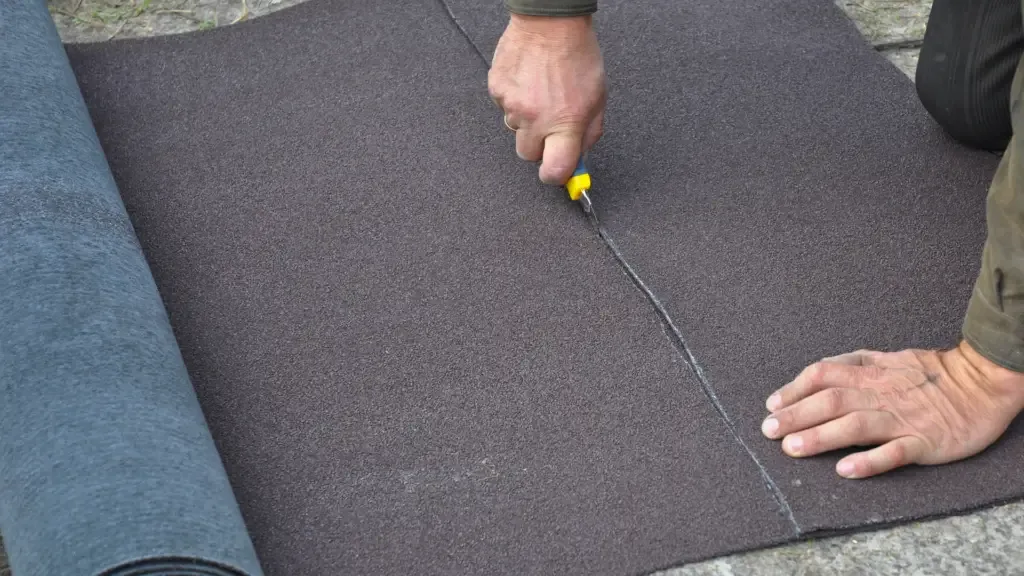
Safety And Regulatory Considerations
When working with roll roofing, it’s important to prioritize safety and be aware of any regulations that may apply to your project. In this section, we will discuss several key safety considerations and potential regulatory issues that you should keep in mind.
First, ensure that you are aware of and follow proper roof safety measures while working with rolled roofing. Doing so will help you avoid injuries and prevent accidents, such as falls, which are a leading cause of death in the construction industry.
Some general safety tips include wearing appropriate personal protective equipment (PPE), using a sturdy ladder or scaffolding, and securing your work area to prevent tools and materials from falling.
When planning your project, check if you need to remove existing shingles before installing rolled roofing. If so, use caution and proper tools to avoid damaging the roof decking or injuring yourself in the process.
A roofing shovel, pry bar, or similar tool can help make removing shingles easier and safer.
Accurate measurements are essential in ensuring a successful roll roofing installation. Having a reliable measuring tape on hand will allow you to properly align and cut your roofing materials.
Mark a chalk line to identify the end of your first layer, usually at 35 inches (89 cm) up from the bottom of the roof, which is the default measurement used by most professionals.
Since rolled roofing is an oil-based asphalt product, it’s crucial to handle and dispose of it properly. Exposure to certain chemicals present in asphalt products can be hazardous, so be sure to follow any relevant guidelines and restrictions.
In some areas, homeowner’s association (HOA) communities may have specific rules and regulations regarding roofing materials and installation methods. Before starting your project, check with your local HOA to ensure that rolled roofing is permitted in your community and that you follow any required procedures.
When installing rolled roofing, be mindful of any features on your roof that may require special attention. These can include gutters, plumbing vents, and skylights.
Make sure to properly seal any seams or junctions where the rolled roofing meets these structures to prevent leaks and maintain the integrity of your roof.
By following the safety and regulatory considerations mentioned in this section, you can help ensure a successful and safe roll roofing project.

